The Due to repeated malware attack, Windows is resetting itself pop-up alert is a misleading advertisement that is created to trick you into calling fake customer support. This fake support service will offer you to buy a subscription to their services and thus solve all problems with the computer. It is clear that there is no real need to buy their services, just ignore this deceptive advertising.
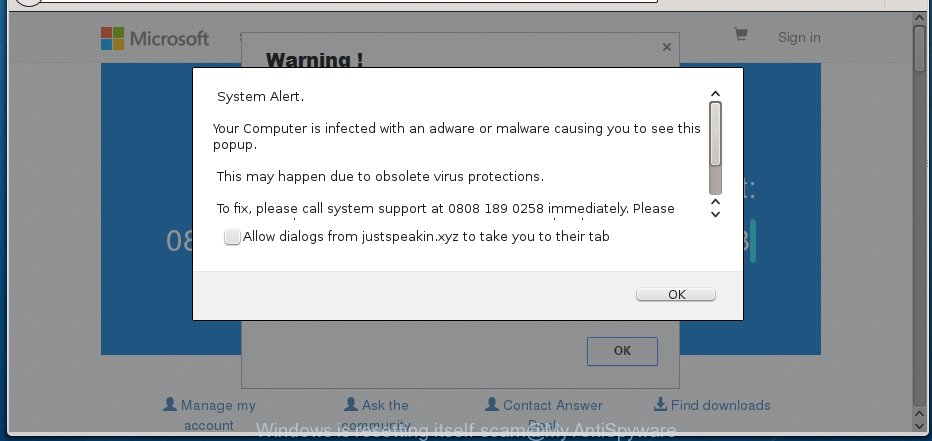
The “Windows is resetting itself” is a misleading advertising like shown above
The full text of this scam is:
Due to repeated malware attack, windows is resetting itself. You may lose your personal files on this computer Your system data has been compromised. Hackers may track your financial activities and get access to your personal files on this system Please report this activity to Don't turn off your computer
If this deceptive advertising began to appear very often, blocking the normal use of your computer or web browser, then most likely your computer is infected with ‘ad-supported’ software (also known as adware). Most likely, you don’t even know how and where this ‘ad supported’ software has got into your computer. In the steps below, we will explain all the general features of adware and its typical behavior on the PC system, as well as effective methods of removing “Windows is resetting itself” fake alerts from your browser.
The adware which cause misleading “Windows is resetting itself” pop-up scam to appear, can attack your computer’s browsers such as the Mozilla Firefox, Chrome, IE and Edge. Maybe you approve the idea that the popups from it is just a small problem. But these undesired “Windows is resetting itself” advertisements eat system resources. The worst is, it has the ability to collect your browsing history and user information, including passwords and credit card numbers. In the future, user information can be transferred third party companies.
It is important, do not trust “Windows is resetting itself” pop-up alerts and do not click on links placed on it, as they may lead you to a more harmful or misleading websites. The best option is to use the guidance posted below to clean your computer of ad-supported software and thus get rid of “Windows is resetting itself” fake alerts.
Remove “Windows is resetting itself” pop up scam
There present several free ‘ad supported’ software removal tools. Also it is possible to get rid of “Windows is resetting itself” popup manually. But we advise to combine all these solutions below into the one removal algorithm. Follow the steps of the guidance. Some of the steps below will require you to exit this web page. So, please read the guidance carefully, after that bookmark or print it for later reference.
To remove “Windows is resetting itself”, execute the steps below:
- How to manually remove “Windows is resetting itself”
- Delete “Windows is resetting itself” related apps through the Control Panel of your system
- Remove “Windows is resetting itself” fake alerts from Mozilla Firefox
- Remove “Windows is resetting itself” fake alerts from Chrome
- Get rid of “Windows is resetting itself” pop-up warnings from Internet Explorer
- Get rid of unwanted Scheduled Tasks
- How to get rid of “Windows is resetting itself” fake alerts with free programs
- Use AdBlocker to block “Windows is resetting itself” and stay safe online
- How did you get infected with “Windows is resetting itself” pop up
- Finish words
How to manually remove “Windows is resetting itself”
If you perform exactly the tutorial below you should be able to delete the “Windows is resetting itself” pop up scam from the Mozilla Firefox, Microsoft Edge, Chrome and IE web browsers.
Delete “Windows is resetting itself” related apps through the Control Panel of your system
First method for manual adware removal is to go into the Windows “Control Panel”, then “Uninstall a program” console. Take a look at the list of software on your computer and see if there are any questionable and unknown apps. If you see any, you need to uninstall them. Of course, before doing so, you can do an World Wide Web search to find details on the program. If it is a potentially unwanted program, adware or malware, you will likely find information that says so.
- If you are using Windows 8, 8.1 or 10 then click Windows button, next click Search. Type “Control panel”and press Enter.
- If you are using Windows XP, Vista, 7, then press “Start” button and click “Control Panel”.
- It will show the Windows Control Panel.
- Further, press “Uninstall a program” under Programs category.
- It will open a list of all apps installed on the PC.
- Scroll through the all list, and delete questionable and unknown applications. To quickly find the latest installed software, we recommend sort programs by date.
See more details in the video tutorial below.
Remove “Windows is resetting itself” fake alerts from Mozilla Firefox
If the Mozilla Firefox web-browser is re-directed to “Windows is resetting itself” and you want to restore the Firefox settings back to their original state, then you should follow the guidance below. Essential information such as bookmarks, browsing history, passwords, cookies, auto-fill data and personal dictionaries will not be removed.
Press the Menu button (looks like three horizontal lines), and click the blue Help icon located at the bottom of the drop down menu as displayed in the figure below.

A small menu will appear, press the “Troubleshooting Information”. On this page, click “Refresh Firefox” button as displayed in the following example.

Follow the onscreen procedure to restore your Firefox web-browser settings to their default values.
Remove “Windows is resetting itself” fake alerts from Chrome
Reset Chrome settings is a easy way to remove the browser hijacker infections, malicious and ‘ad-supported’ extensions, as well as to recover the internet browser’s default search provider, home page and newtab that have been replaced by adware which cause misleading “Windows is resetting itself” popup scam to appear.

- First, start the Chrome and press the Menu icon (icon in the form of three dots).
- It will open the Chrome main menu. Select More Tools, then click Extensions.
- You will see the list of installed extensions. If the list has the plugin labeled with “Installed by enterprise policy” or “Installed by your administrator”, then complete the following guidance: Remove Chrome extensions installed by enterprise policy.
- Now open the Chrome menu once again, click the “Settings” menu.
- Next, press “Advanced” link, which located at the bottom of the Settings page.
- On the bottom of the “Advanced settings” page, click the “Reset settings to their original defaults” button.
- The Chrome will open the reset settings dialog box as on the image above.
- Confirm the web-browser’s reset by clicking on the “Reset” button.
- To learn more, read the blog post How to reset Google Chrome settings to default.
Get rid of “Windows is resetting itself” pop-up warnings from Internet Explorer
If you find that Internet Explorer web-browser settings such as home page, search provider by default and new tab page having been changed by ‘ad supported’ software that developed to display misleading “Windows is resetting itself” fake alerts within your browser, then you may restore your settings, via the reset web-browser procedure.
First, launch the Internet Explorer, click ![]() ) button. Next, click “Internet Options” as shown on the screen below.
) button. Next, click “Internet Options” as shown on the screen below.

In the “Internet Options” screen select the Advanced tab. Next, press Reset button. The Internet Explorer will open the Reset Internet Explorer settings dialog box. Select the “Delete personal settings” check box and click Reset button.

You will now need to reboot your system for the changes to take effect. It will delete ‘ad supported’ software that created to show misleading “Windows is resetting itself” pop up within your internet browser, disable malicious and ad-supported browser’s extensions and restore the Internet Explorer’s settings like newtab, homepage and default search engine to default state.
Get rid of unwanted Scheduled Tasks
If the annoying “Windows is resetting itself” web page opens automatically on Windows startup or at equal time intervals, then you need to check the Task Scheduler Library and get rid of all tasks which have been created by ‘ad-supported’ software.
Press Windows and R keys on the keyboard simultaneously. This shows a prompt that titled as Run. In the text field, type “taskschd.msc” (without the quotes) and press OK. Task Scheduler window opens. In the left-hand side, press “Task Scheduler Library”, as displayed in the figure below.
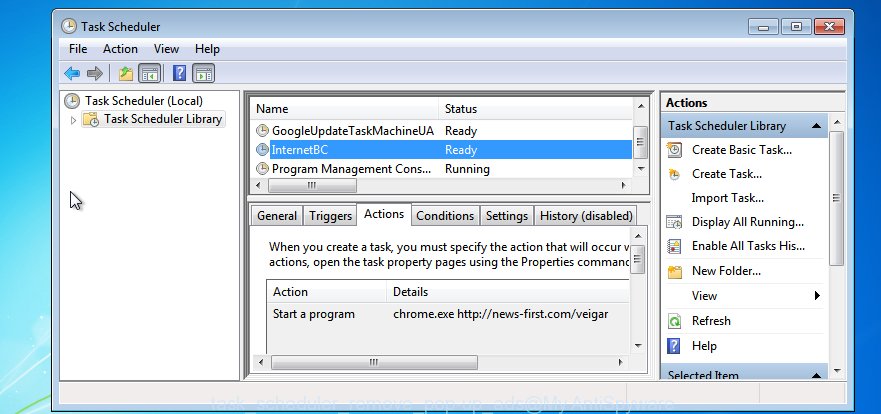
Task scheduler
In the middle part you will see a list of installed tasks. Please select the first task, its properties will be open just below automatically. Next, click the Actions tab. Pay attention to that it launches on your system. Found something like “explorer.exe http://site.address” or “chrome.exe http://site.address”, then get rid of this malicious task. If you are not sure that executes the task, check it through a search engine. If it is a component of the ‘ad-supported’ application, then this task also should be removed.
Having defined the task that you want to remove, then click on it with the right mouse button and choose Delete as displayed on the screen below.

Delete a task
Repeat this step, if you have found a few tasks which have been created by adware. Once is complete, close the Task Scheduler window.
How to get rid of “Windows is resetting itself” fake alerts with free programs
Many antivirus companies have developed apps that help detect adware and thereby delete “Windows is resetting itself” from the Google Chrome, Mozilla Firefox, Edge and Microsoft Internet Explorer web-browsers. Below is a a few of the free programs you may want to use. Your system can have tons of PUPs, adware and hijackers installed at the same time, so we recommend, if any unwanted or harmful program returns after rebooting the PC, then start your personal computer into Safe Mode and use the anti-malware tool again.
Scan and free your internet browser of “Windows is resetting itself” pop-up with Zemana Anti-malware
We recommend using the Zemana Anti-malware which are completely clean your PC system of the adware. The utility is an advanced malware removal program developed by (c) Zemana lab. It’s able to help you remove potentially unwanted apps, browser hijacker infections, malware, toolbars, ransomware and ‘ad supported’ software that causes web browsers to show misleading “Windows is resetting itself” pop-up.
Installing the Zemana Anti-Malware is simple. First you will need to download Zemana by clicking on the link below.
164818 downloads
Author: Zemana Ltd
Category: Security tools
Update: July 16, 2019
When downloading is complete, close all software and windows on your computer. Open a directory in which you saved it. Double-click on the icon that’s named Zemana.AntiMalware.Setup as displayed in the following example.
![]()
When the setup starts, you will see the “Setup wizard” that will help you set up Zemana on your PC system.

Once installation is finished, you will see window like below.

Now click the “Scan” button to start checking your machine for the ad-supported software that causes browsers to display misleading “Windows is resetting itself” pop up warnings. A scan can take anywhere from 10 to 30 minutes, depending on the count of files on your system and the speed of your machine. While the Zemana application is scanning, you may see how many objects it has identified as threat.

When Zemana AntiMalware has finished scanning your PC, Zemana Anti Malware (ZAM) will open a scan report. Make sure all threats have ‘checkmark’ and click “Next” button.

The Zemana Free will remove ad-supported software that causes misleading “Windows is resetting itself” pop-up scam on your web-browser and add items to the Quarantine.
Delete “Windows is resetting itself” popup warnings from browsers with Hitman Pro
HitmanPro is a completely free (30 day trial) tool. You do not need expensive solutions to delete adware that causes web-browsers to show misleading “Windows is resetting itself” popup and other shady apps. Hitman Pro will uninstall all the undesired applications such as adware and browser hijackers for free.
Please go to the following link to download the latest version of Hitman Pro for Microsoft Windows. Save it on your MS Windows desktop or in any other place.
After downloading is complete, open the file location. You will see an icon like below.

Double click the Hitman Pro desktop icon. When the utility is started, you will see a screen as shown in the following example.
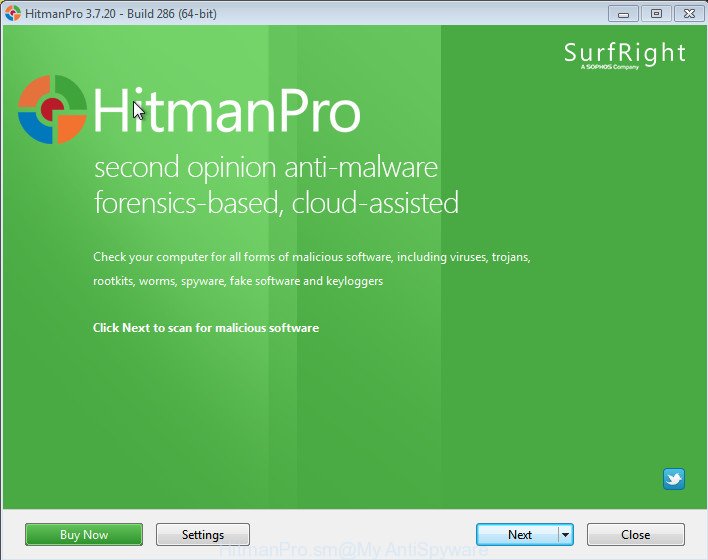
Further, click “Next” button to find ‘ad supported’ software that causes web-browsers to display misleading “Windows is resetting itself” pop-up warnings. A scan can take anywhere from 10 to 30 minutes, depending on the count of files on your computer and the speed of your computer. When Hitman Pro has finished scanning your computer, HitmanPro will show a scan report as displayed on the screen below.
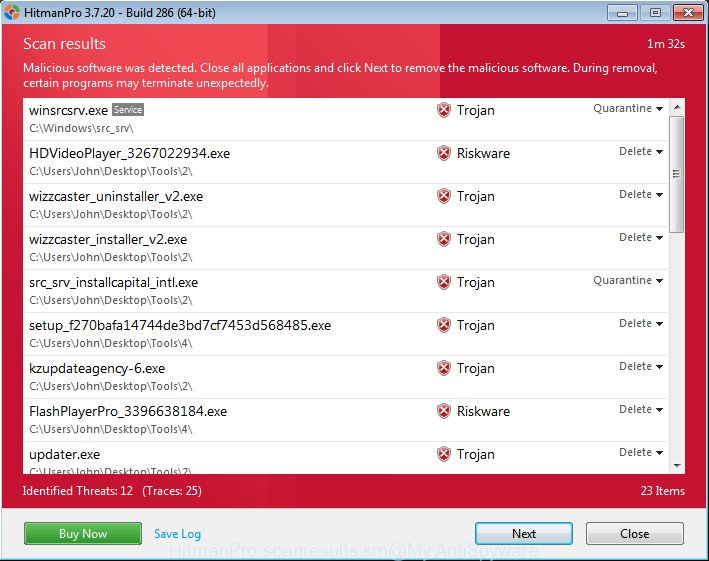
When you’re ready, press “Next” button. It will display a dialog box, click the “Activate free license” button.
Use Malwarebytes to delete “Windows is resetting itself” pop-up scam
Remove “Windows is resetting itself” fake alerts manually is difficult and often the adware is not completely removed. Therefore, we recommend you to use the Malwarebytes Free which are completely clean your machine. Moreover, the free application will help you to delete malware, potentially unwanted software, toolbars and browser hijackers that your computer can be infected too.
Installing the MalwareBytes is simple. First you’ll need to download MalwareBytes on your PC system from the following link.
327074 downloads
Author: Malwarebytes
Category: Security tools
Update: April 15, 2020
After the downloading process is finished, close all programs and windows on your computer. Double-click the set up file named mb3-setup. If the “User Account Control” prompt pops up as shown in the figure below, click the “Yes” button.
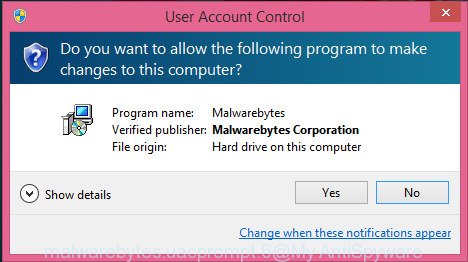
It will open the “Setup wizard” which will help you setup MalwareBytes AntiMalware on your computer. Follow the prompts and don’t make any changes to default settings.
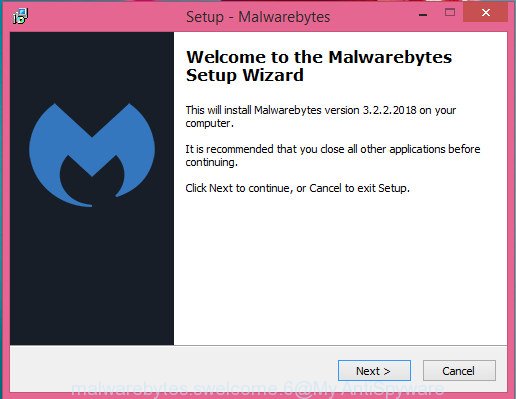
Once install is finished successfully, click Finish button. MalwareBytes Anti-Malware (MBAM) will automatically start and you can see its main screen as shown on the image below.
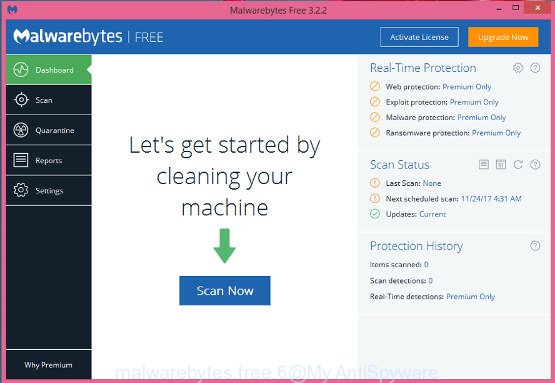
Now click the “Scan Now” button to start scanning your computer for the ad-supported software that displays misleading “Windows is resetting itself” pop up warnings on your system. This process may take quite a while, so please be patient. While the MalwareBytes AntiMalware program is checking, you can see number of objects it has identified as threat.
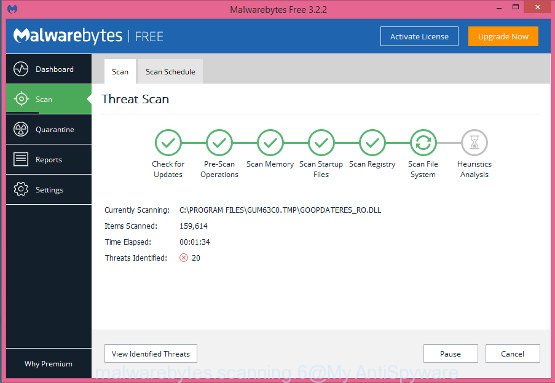
Once MalwareBytes has finished scanning, you will be shown the list of all detected threats on your machine. You may remove threats (move to Quarantine) by simply click “Quarantine Selected” button. The MalwareBytes Anti-Malware will remove adware that shows misleading “Windows is resetting itself” pop-up warnings on your PC. When the cleaning process is finished, you may be prompted to reboot the computer.
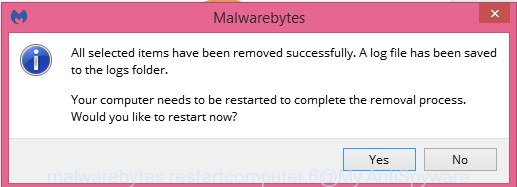
We recommend you look at the following video, which completely explains the process of using the MalwareBytes to delete adware, browser hijacker and other malware.
Use AdBlocker to block “Windows is resetting itself” and stay safe online
Using an ad-blocking program like AdGuard is an effective way to alleviate the risks. Additionally, ad-blocking programs will also protect you from malicious advertisements and sites, and, of course, stop redirection chain to “Windows is resetting itself” and similar pages.
Installing the AdGuard is simple. First you’ll need to download AdGuard on your Windows Desktop from the link below.
26846 downloads
Version: 6.4
Author: © Adguard
Category: Security tools
Update: November 15, 2018
Once the download is done, run the downloaded file. You will see the “Setup Wizard” screen as displayed below.

Follow the prompts. Once the installation is finished, you will see a window as displayed in the figure below.

You can click “Skip” to close the setup program and use the default settings, or click “Get Started” button to see an quick tutorial that will allow you get to know AdGuard better.
In most cases, the default settings are enough and you don’t need to change anything. Each time, when you run your computer, AdGuard will start automatically and block pop up ads, “Windows is resetting itself” redirect, as well as other harmful or misleading web-sites. For an overview of all the features of the program, or to change its settings you can simply double-click on the AdGuard icon, which can be found on your desktop.
How did you get infected with “Windows is resetting itself” pop up
The adware usually spreads in the composition, together with another program in the same installer. The risk of this is especially high for the various free software downloaded from the Internet. The authors of the software are hoping that users will use the quick setup mode, that is simply to press the Next button, without paying attention to the information on the screen and don’t carefully considering every step of the installation procedure. Thus, the adware can infiltrate your computer without your knowledge. Therefore, it is very important to read all the information that tells the program during installation, including the ‘Terms of Use’ and ‘Software license’. Use only the Manual, Custom or Advanced install mode. This mode will help you to disable all optional and unwanted applications and components.
Finish words
Now your machine should be clean of the ad-supported software that causes multiple misleading “Windows is resetting itself” alerts and pop ups. We suggest that you keep AdGuard (to help you block unwanted popup advertisements and undesired malicious webpages) and Zemana Anti Malware (ZAM) (to periodically scan your PC for new malware, browser hijackers and adware). Make sure that you have all the Critical Updates recommended for Windows operating system. Without regular updates you WILL NOT be protected when new browser hijackers, harmful software and adware are released.
If you are still having problems while trying to delete “Windows is resetting itself” pop up warnings from your internet browser, then ask for help in our Spyware/Malware removal forum.


















